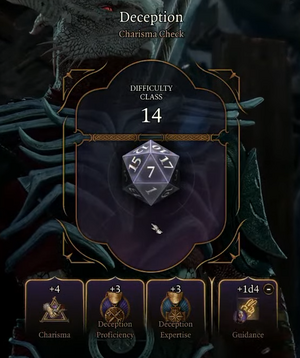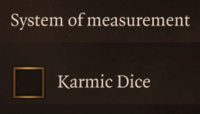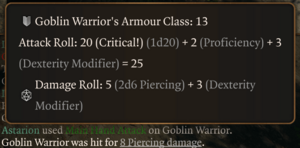Dice rolls: Difference between revisions
Guybrush42 (talk | contribs) (Streamlining) |
Guybrush42 (talk | contribs) m (→Damage Rolls) |
||
| Line 117: | Line 117: | ||
A '''Damage Roll''' is made when an attack is successful, a spell hits a target, a trap is activated, and so on. The result determines the damage dealt to an affected creature or object, measured in [[Hit Points]]. This roll can involve any size and number of dice, determined by the source of the damage. Damage rolls also have a [[Damage Types|Damage Type]]. | A '''Damage Roll''' is made when an attack is successful, a spell hits a target, a trap is activated, and so on. The result determines the damage dealt to an affected creature or object, measured in [[Hit Points]]. This roll can involve any size and number of dice, determined by the source of the damage. Damage rolls also have a [[Damage Types|Damage Type]]. | ||
For example, a [[Dagger]] uses a single D4 for Damage Rolls, and deals Piercing Damage. Assuming no modifiers apply, the game expresses this as "1d4 (1-4) damage - {{DamageType|Piercing}}". Most weapons use a single die, though [[Greatswords]] and some other weapons deal 2d6 damage. | For example, a [[Dagger]] uses a single D4 for Damage Rolls, and deals Piercing Damage. Assuming no modifiers apply, the game expresses this as "1d4 (1-4) damage - {{DamageType|Piercing}}". Most weapons use a single die, though [[Greatswords]] and some other weapons deal 2d6 damage. Spells usually deal multiple dice of damage but without any modifiers; for example, being caught in a {{SAI|Fireball}} will cause 8d6 points of fire damage, though a successful Saving Throw (see above) can reduce it to half. | ||
==== Damage Roll Modifiers ==== | ==== Damage Roll Modifiers ==== | ||
Revision as of 03:30, 18 October 2023
Attacking a creature, making a shove attempt, spotting a hidden secret, and picking a lock are all examples of die rolls, which are the main method used to determine character success or failure in BG3. Dice are also rolled to determine varying levels of success, such as the amount of damage a character deals in combat, or outcomes selected at random, like the effects of chaos magic.
Dice Roll Basics
In most circumstances, when a character makes a die roll to determine success, they use a twenty-sided die (or ![]() d20) and add a relevant Ability Score Modifier and Proficiency Bonus (if the character has the relevant proficiency) to the roll to determine the final result. Other modifiers may come from a character's situation, equipment, spells, potions or other effects.
d20) and add a relevant Ability Score Modifier and Proficiency Bonus (if the character has the relevant proficiency) to the roll to determine the final result. Other modifiers may come from a character's situation, equipment, spells, potions or other effects.
For most such rolls, the result must meet or exceed a specific target to be considered a success. This target value is called the Difficulty Class of the roll. Rolling a 1 or 20 on a D20 is referred to as a "Natural 1" or "Natural 20". On some rolls, these can have special effects, including automatic failure or succeess, regardless of Modifiers and Difficulty Class.
Other kinds of rolls, primarily Damage Rolls, may use other kinds of dice, may or may not add modifiers, and rarely use the Proficiency Bonus.
Dice Notation
Types of dice are referred to by the number of sides they have: ![]() D4,
D4, ![]() D6,
D6, ![]() D8,
D8, ![]() D10,
D10, ![]() D12, and
D12, and ![]() d20. Abbreviations are used to refer to the total number of dice used in a roll, such as 1d6 for rolling one D6 die, 2d4 for rolling two D4 dice, 8d6 for rolling eight D6 dice and so on.
d20. Abbreviations are used to refer to the total number of dice used in a roll, such as 1d6 for rolling one D6 die, 2d4 for rolling two D4 dice, 8d6 for rolling eight D6 dice and so on.
The results on multiple dice rolled in this way are added together to give a final total. This notation can also include modifiers, and the range of results is usually given in parentheses. For example, a single dart from a spell does 1d4+1 (2-5) Force damage, meaning it rolls 1d4 and adds 1 to the result, giving a possible total of between 2 and 5 points of damage.
Karmic Dice
When the Karmic Dice option is enabled (the default), the game will avoid frustrating streaks of very low rolls in a row.
However, Karmic Dice influence all rolls – including those of enemies – and the results will only ever skew toward a positive result for the dice roller. In short, the Karmic Dice setting makes combat encounters quicker and deadlier for both you and your enemies.
The exact algorithm for Karmic Dice is not presently known and may be changed between versions of the game.
Karmic Dice was previously referred to as 'Loaded Dice'.
Advantage / Disadvantage
Main page: Advantage
In various situations, a creature can have ![]() Advantage or
Advantage or ![]() Disadvantage on a D20 roll.
Disadvantage on a D20 roll.
Advantage means that you make the roll twice and use the higher result. Disadvantage means you use the lower result.
Advantage and Disadvantage cannot stack. In other words, you never roll more than twice. Additionally, they cancel each other out, no matter how many sources of Advantage or Disadvantage you have. For instance, if you had three sources of Advantage and only one source of Disadvantage, they would still cancel each other out, causing you to roll normally.
D20 Rolls
Attack Rolls, Saving Throws and Ability Checks all use a ![]() d20, and result in either success or failure. All are modified by a relevant Ability Score Modifier and Proficiency Bonus, and can be made with
d20, and result in either success or failure. All are modified by a relevant Ability Score Modifier and Proficiency Bonus, and can be made with ![]() Advantage or
Advantage or ![]() Disadvantage.
Disadvantage.
Attack Roll
Main page: Attack Roll
An Attack Roll is a ![]() d20 roll made when one creature attacks another. The Difficulty Class for the roll is the Armour Class (AC) of the target; if it meets or exceeds the AC, then the attack is a hit. Otherwise, it's a miss. (Fictionally, this need not mean a literal miss; it just means the target will not take any damage from the attack.)
d20 roll made when one creature attacks another. The Difficulty Class for the roll is the Armour Class (AC) of the target; if it meets or exceeds the AC, then the attack is a hit. Otherwise, it's a miss. (Fictionally, this need not mean a literal miss; it just means the target will not take any damage from the attack.)
Attacks made with Weapons always use an Attack Roll to determine success. Some spells also use an Attack Roll, usually those that involve beams or projectiles that need to be aimed at a target (such as or ). Creatures or objects conjured by spells (such as or ) can often attack on their own turns, and make an Attack Roll to do so.
Spells which directly affect a target (such as ) or which cause an effect at a point in space (such as or ) don't require an Attack Roll, but usually allow affected creatures to make a Saving Throw instead (see below).
A successful Attack Roll results in a separate Damage Roll to determine the amount of damage done to the target.
Critical Miss / Critical Hit
On Attack Rolls, a Natural 1 means the attack fails regardless of bonuses or the target's Armour Class. This is called a Critical Miss.
Likewise, a Natural 20 means the attack succeeds regardless of the target's Armour Class. This is called a Critical Hit. A Critical Hit also affects the result of the Damage Roll: it doubles the normal number of damage dice rolled (including additional dice such as those from Smites or Combat Manoeuvers). Flat damage bonuses from modifiers or other sources (such as ) are not affected by a critical hit.
Some class features and other effects can improve Critical Hits, either by making them more likely ( ) or by increasing the extra damage ( ).
Attack Roll Modifiers
The Ability Score Modifier used for an Attack Roll depends on the type of attack being made. Melee and ranged weapon attacks use Strength or Dexterity, depending on the weapon. Spells use a specific Spellcasting Ability Modifier usually determined by the caster's class; see the main Attack Roll page for details.
For weapon attacks, a creature's Proficiency Bonus is added to the roll if it is proficient with the type of weapon used. For spells, it's based on whether the creature has any innate spell casting capability granted by its class, subclass, or Feats.
Saving Throw
Main page: Saving Throw
A ![]() Saving throw (or "save" for short) is a
Saving throw (or "save" for short) is a ![]() d20 roll made to avoid or reduce the harm from a source of danger. This could mean dodging a dart or burst of flame from a sprung trap, resisting the effects of poisons or mind-altering magic, or trying to take cover to reduce damage from an explosion.
d20 roll made to avoid or reduce the harm from a source of danger. This could mean dodging a dart or burst of flame from a sprung trap, resisting the effects of poisons or mind-altering magic, or trying to take cover to reduce damage from an explosion.
The Difficulty Class (DC) is determined by the source of danger. Traps, dialogue events and other sources of danger controlled by the game have a Difficulty Class defined by the game, depending on how serious the danger is. Spells and Weapon Actions use specific formulas to determine the DC:
- Spell saves have a DC determined by the creature's Spellcasting Ability Modifier:
- Weapon Action saves have a DC determined by the creature's Dexterity or Strength - whichever is higher - and a Weapon Ability's inherent DC Bonus, using the following formula:
Saving Throw Modifiers
The Ability Score Modifier used for a save is determined by the source of danger. For example, evading a spike trap may require Dexterity, whereas trying to resist the effects of a poisonous gas would require Constitution. They are usually referred to by the Ability used, for example "Strength Saving Throw" or "Strength Save". Dexterity, Constitution and Wisdom Saving Throws are much more common than Strength, Intelligence or Charisma Saves.
The Proficiency Bonus is only added if the creature has Proficiency in the corresponding type of Saving Throw. This is generally granted by a creature's Class, each of which comes with two Saving Throw Proficiencies.
Some magical effects and items may also grant bonuses to Saving Throws.
Effect of Success
A successful Save can mean completely avoiding negative effects, reducing the damage received (usually by half), or both. For example, successfully saving against a spike trap could mean that a creature takes no damage at all, because it successfully evaded the spikes. On the other hand, if it's caught in the area of effect of a , then a successful save will merely halve the damage. Saving against both halves the damage taken, and prevents a creature from being pushed by the spell.
Some effects don't allow for a Saving Throw at all, for example the spell .
Ability Check
Main page: Ability Check
Various actions, other than attacking or making a save, still require the creature to make an attempt that may fail. The creature rolls a D20, and adds its Ability Score Modifier and possibly its Proficiency Bonus. The attempted action has a specific Difficulty Class which the result of the roll must match or exceed.
Some Ability Checks are based only on the base Ability Score. A common example is exerting willpower to use the Tadpole's influence on other characters during dialogue. Checks like this have no applicable proficiency, and never add a proficiency bonus.
Skill Check
Most Ability Checks are tasks related to a specific Skill, also known as Skill Checks. Each Skill is associated with a specific Ability Score, and lets the creature add its Proficiency Bonus to the check if they are Proficient in that Skill. Some class features may grant Expertise, which doubles the Proficiency Bonus for one or more specific Skills.
Some Skill Checks are instigated by the player, while others are automatically triggered in response to other player actions. For example, when a character nears an unactivated trap, the game rolls a Perception Skill Check (or in short, "rolls Perception") to determine whether they notice it. Perception is a Wisdom Skill, so the character adds their Wisdom Modifier and, if proficient in Perception, their Proficiency Bonus. Once the trap is seen, the character can interact with it to attempt to Disarm it, which requires a successful Sleight of Hand Check, a Dexterity Skill.
Skill Checks are also common during dialogue, where some responses require a Skill Check to determine the outcome. Examples include using Charisma-based Skills like Persuasion, Deception or Intimidation to influence others, or Intelligence-based Skills like Investigation, History or Religion to determine or remember facts.
Contest
A Contest is a special type of Ability Check in which two creatures both roll an Ability Check or Skill Check to oppose each other, and one wins over the other. The creatures don't necessarily roll the same type of check.
An example of this is the action. The creature attempting the Shove rolls Athletics, and the defending creature rolls either Athletics or Acrobatics (the game chooses the Skill with the highest bonus) to contest the Shove. If the attacker's roll is higher than the defender's, the Shove succeeds; otherwise it fails.
Other Rolls
Damage Rolls
Main page: Damage Roll
A Damage Roll is made when an attack is successful, a spell hits a target, a trap is activated, and so on. The result determines the damage dealt to an affected creature or object, measured in Hit Points. This roll can involve any size and number of dice, determined by the source of the damage. Damage rolls also have a Damage Type.
For example, a Dagger uses a single D4 for Damage Rolls, and deals Piercing Damage. Assuming no modifiers apply, the game expresses this as "1d4 (1-4) damage - ![]() Piercing". Most weapons use a single die, though Greatswords and some other weapons deal 2d6 damage. Spells usually deal multiple dice of damage but without any modifiers; for example, being caught in a will cause 8d6 points of fire damage, though a successful Saving Throw (see above) can reduce it to half.
Piercing". Most weapons use a single die, though Greatswords and some other weapons deal 2d6 damage. Spells usually deal multiple dice of damage but without any modifiers; for example, being caught in a will cause 8d6 points of fire damage, though a successful Saving Throw (see above) can reduce it to half.
Damage Roll Modifiers
Attacks made with weapons always add the attacking creature's Ability Score Modifier, generally Strength or Dexterity (whichever was used for the Attack Roll). Spell attacks generally do not add such a modifier, except when explicitly granted by a magical item or class feature, such as the Warlock's invocation. Some magical affects, like the spell or a Warlock's , allow spellcasters to use their Spellcasting Ability Modifier for weapon Attack and Damage Rolls.
Initiative
Main page: Initiative
When combat starts, all combatants make an Initiative roll to determine the turn order. This is effectively a Dexterity Ability Check, but is made using a D4 instead of a ![]() d20. Proficiency does not normally apply, but some class features, spells and magical items can provide bonuses to the Initiative roll.
d20. Proficiency does not normally apply, but some class features, spells and magical items can provide bonuses to the Initiative roll.
Random Results
Some class features, spells and other, usually magical effects are selected randomly from a list of possibilities. The dice rolled for these varies, but is usually a single die, meaning each option has equal chance of occuring. Effects that work this way include:
- The Wild Magic feature of the Wild Magic Sorcerer
- The Rage: Wild Magic feature of the Wild Magic Barbarian


